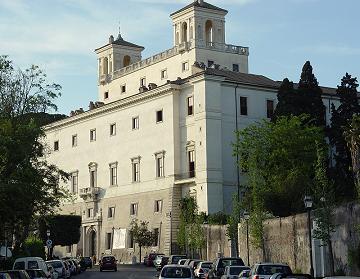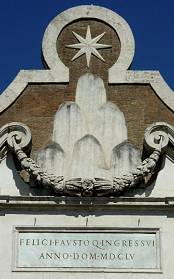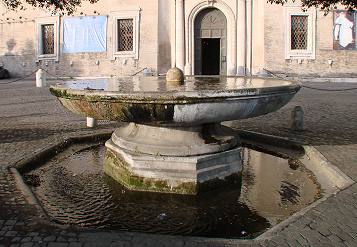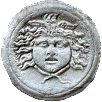
Villa Medici |
Not far from the Spanish Steps, above the Pincio Hill, facing a charming view over the city, stands the beautiful Villa Medici. The 16th century building was given this name after one of its first owners, Ferdinando de' Medici. A cardinal at first, he was later appointed grand duke of Tuscany, and he chose this villa as the official Roman residence for the ambassadors of his grand duchy.
In 1803, while Rome was under a French administration, Napoleon took possession of the building, and moved the Academy
of France there; still today Villa Medici officially belongs to France, and the country pays a symbolic rent for keeping posession of the historic building.
The original bronze doors of the villa are still in place; one of them has a rather large circular dent, which is related to a curious legend. |
This legend though is not about the the villa's owner, but about a queen, and a rather peculiar one too: Christina of Sweden, one of the most highly cultured women of the 17th century and probably the one with the strongest character.
She was born in 1626, and was proclaimed queen already at the age of six. In her youth she was particularly brilliant with her studies. Unlike most women of her age, she freely decided not to marry. Then she secretly converted to the Catholic religion, despite being the ruler of a Lutheran country. And when her controversial choice led her to major contrasts with high members of her court, in 1654 she abdicated and left her native country. But even later, she maintained her title, and lived for the rest of her life surrounded by a small court of faithful dignitaries.

Christina of Sweden (1626-1689) |
One year after her abdication she came to Rome, where she was lavishly received by Alexander VII; on this occasion a welcome inscription and a large heraldic device referring to the pope were carved by Gianlorenzo Bernini above Porta del Popolo, the city's northernmost gate through which the queen entered on December 19 (or 23, according to some sources), 1655, with a long parade of 255 people, most of which on horseback. Curiously, by that time she already spoke a fluent Italian, without ever having been to Italy before. |
In Rome she dwelt in several residences; after a temporary stay in the Tower of Winds (an astronomical tower by the Courtyard of the Pine-cone, in the Vatican), Alexander VII let her move into Palazzo Farnese, which had already been left uninhabited by that time. But when on the following year the queen left for France, where she discussed with the famous cardinal Mazarine the opportunity of being proclaimed queen of Naples, it was found out that her court, besides having stolen precious objects and works of art from the Roman palace, had even used the wooden doors of some halls for lighting the fire! |

the inscription above Porta del Popolo:
TO A HAPPY AND PROPITIOUS ENTRANCE
IN THE YEAR 1655 |
So when she returned, in 1658, she was asked to move to Palazzo Rospigliosi, and then to Palazzo Riario (presently Palazzo Corsini), located in Trastevere district; in the latter residence Christina used to meet several famous artists and men of letters, such as the composer Alessandro Scarlatti, the playright Carlo Goldoni, the poet Pietro Metastasio, the same aforesaid architect and sculptor Bernini, and many others. This circle led to the foundation of the famous academy known as the Arcadia.
Besides being fond of arts, Christina had an interest also in scientific fields and even in esoteric practices, as explained more in detail in The Magic Door, in the Curious and Unusual section.
Christina fancied lavish parades and carousels, and members of Rome's high nobility sometimes organized for her similar events, as a token of friendship; one of the most grand took place at Palazzo Barberini soon after her arrival, on February 28, 1656, and is remembered by a large painting now in the Museum of Rome (see picture below).
The Swedish queen was also known for her haughtiness, for her complex and controversial personality, and for her rather extravagant and sometimes unorthodox habits: she freely socialized with men, she sat crossing her legs, and often vented out her whimsical temper using foul words. In her autobiography she wrote that "women should never reign", yet having reigned herself for 22 years!
Also her observance of religious rules as a Catholic was never too strict; nevertheless, her friendship with pope Alexander VII and with many personalities granted her such privilege.
In fact, her stay in Rome was spangled with curious anecdotes. |

Christina on horseback,
dressed as a man |
 |
For instance, one day, while visiting the Vatican, she was shown the large fountain in St.Peter's square - in those days only one of the two twin fountains now standing there was already extant - and on turning away she said to those who accompanied her: "Thank you, now you can turn off the water"!
She also caused sensation for moving around the city on horseback, dressed as a man, disregarding the luxury carriage that the pope had set at her disposal. All in all, she was indeed a bizarre personage.
← the grand carousel in honour of Christina of Sweden, held at
Palazzo Barberini (painting by Filippo Lauri and Filippo Gagliardi) |
After her death, in 1689, she was buried in the Vatican Grottoes below St.Peter's in the Vatican, among the popes, and also had a large monument dedicated to her memory inside the basilica, the only monarch ever credited with such honours.

cardinal Decio Azzolino |
The legend Christina is most remembered for in Rome is about the gun-shot that she is said to have fired one day towards Villa Medici.
The most likely version of the anectode also concerns cardinal Decio Azzolino, a brilliant minded man, a liberal and an anti-nepotist, whom the former queen was a close friend to, so close that in those days they might have raised suspects; in fact, some maintain that they were lovers. Apparently, one day they were supposed to meet by Villa Medici, but the cardinal did not show up, as they had agreed. In a rage for having been disappointed, Christina rushed to Sant'Angelo Castle and fired against Villa Medici one of the several cannons that the terraces of the fortress were armed with. |
Some others claim that the episode took place after friction had developed for some reason between the lady and the Medici family.
Christina's memorial (basilica of St.Peter in the Vatican)→ |
 |

the fountain facing the villa's door;
note the marble sphere, in the center |
Whatever the story may have been, the cannonball reached Villa Medici's bronze door, leaving on one of its panels the aforesaid round dent.
Facing the building stands a 16th century fountain, where a stone sphere spouts water into a round basin: this is said to be the same cannon ball shot by the queen which, having been found still in good condition despite the impact, was then used as a decoration. |

the round dent on
Villa Medici's door |
Although no evidence can be given that Christina of Sweden never really fired the weapon, it would have been very unlikely for anybody, if not impossible, to deliver such a heavy ball at a distance of about 1,5 Km, i.e. almost one mile, from the castle to the villa (see the aerial view on the right), because no cannon available in Sant'Angelo Castle by the 17th century was sufficiently powerful to cover that range.
The legend now seems to have fallen into oblivion; but in older days, no tourist guide nor carriage driver showing the Pincio Hill to visitors would have forgotten to mention queen Christina and her outburst of folly. |
 |




|